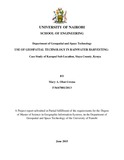| dc.description.abstract | Kenya is currently experiencing growing pressure on water resources caused by increasing water
demand for agricultural, domestic and industrial consumption. This has been brought about due
the effects of climate change and has necessitated the need to maximize and augment the use of
existing or unexploited sources of fresh water. Rain Water Harvesting (RWH) has been
considered as the most promising among others with efforts currently being made world over to
provide water to meet the growing need. The focus of this study was to use geo-information
technology in assessing the potential of rooftop rainwater harvesting (RRWH). Rooftop
rainwater harvesting is the technique through which rain water is captured from the roof
catchments and stored in reservoirs for future use.
The study was executed in Karapul sub-location in Siaya County, Kenya. The sub-location has
had to contend with a water scarcity problem for decades owing to frequent droughts, changing
climate pattern, fast growing population and the increasing demand for clean and safe drinking
water. A total of 8,024 rooftops were digitized in the ArcGIS environment from ortho-rectified
aerial photography of 40cm spatial resolution. Three different classes of rooftop types were
captured in the digitization process, these were, iron sheets, tiles and grass thatched rooftop
types. Run-off coefficients of 0.85, 0.6 and 0.2 were respectively assigned to the three rooftop
classes. Estimated rainfall surfaces from the year 2000 - 2012 were used to extract mean monthly
and mean annual rainfall. A local model combining, mean annual rainfall (Rt), rooftop run-off
co-efficient (Rc) and average roof area (A) was used to estimate the rainwater harvesting
potential.
Results from this work showed that 89% (389,528 km²) of the area of study has a high potential
for rainwater harvesting. The total estimated potential for the area of study was 588,301 m³ of
rain water, with iron sheet rooftops accounting for 95.6% (562,869 m³) while grass-thatched
rooftops accounted for 2.3% (13,276 m³) and tiled rooftop accounted for 2% (12,157 m³) of the
potential. The outcome of this study highlighted the relevance of geospatial methods and tools in
assessing rainwater harvesting potential. The results from this work are intended to aide in
planning water provision and to help address the water scarcity problem in Karapul Sub-location.
In addition, the methodology outlined in this study can be replicated in other areas in Kenya to
determine the potential of rainwater harvesting and thus integrate rainwater as an alternative
water source to ensure sustainable development.
The use of existing wells to act as storage for rainwater and geological studies to investigate the
reason for drying wells and the fluctuating water struck levels are some of the recommendations.
Key words: Rainwater Harvesting Potential, Rooftop Rainwater Harvesting, Geospatial
Technology, Runoff Coefficient | en_US |

